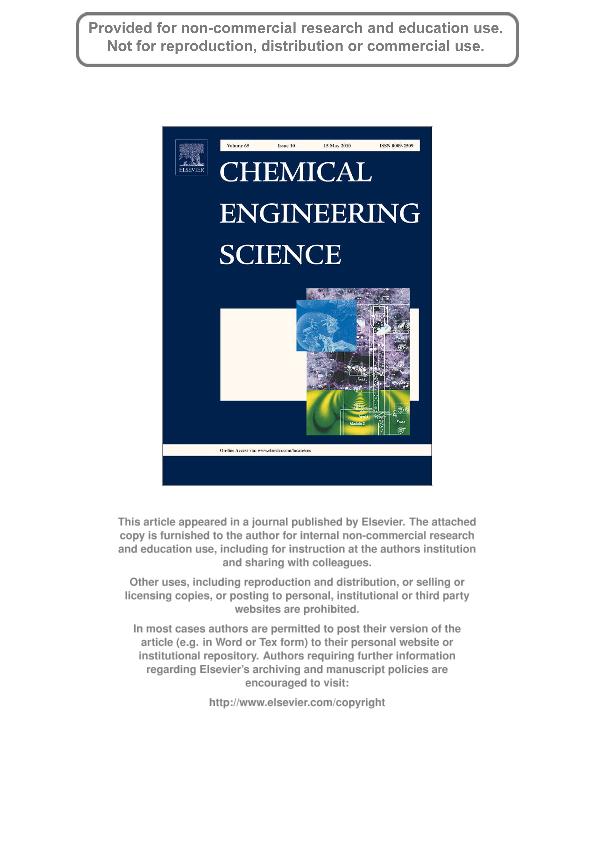Mostrar el registro sencillo del ítem
dc.contributor.author
Ubal, Sebastian

dc.contributor.author
Harrison, C. H.
dc.contributor.author
Grassia, P.
dc.contributor.author
Korchinsky, W. J.
dc.date.available
2017-03-09T20:08:25Z
dc.date.issued
2010-05
dc.identifier.citation
Ubal, Sebastian; Harrison, C. H.; Grassia, P.; Korchinsky, W. J.; Numerical simulation of mass transfer in circulating drops; Elsevier; Chemical Engineering Science; 65; 10; 5-2010; 2934-2956
dc.identifier.issn
0009-2509
dc.identifier.uri
http://hdl.handle.net/11336/13698
dc.description.abstract
Numerical simulations of mass transfer are performed for a circulating liquid drop with applications in liquid–liquid extraction. Simulation parameters are chosen for a multi-component ternary system acetone–methanol–benzene. The drop circulation pattern is estimated via a truncated Galerkin representation of the drop streamfunction. Fickian diffusivities for multi-component mass transfer are obtained via Maxwell–Stefan theory with thermodynamic corrections. The advection–diffusion equations governing mass transfer are solved via two distinct numerical methods: a finite difference scheme (using the alternating direction implicit method) and a finite element scheme. Good agreement was obtained between both schemes. Simulation results are presented for a Reynolds number (Re=30) and for a selection of Peclet numbers (Pe=100, 1000 and 10 000, thereby giving insight into the effects of increasing Peclet number). The numerical simulations of the full advection–diffusion equations are compared against predictions of a rigid drop model (i.e. without circulation) and also against predictions of a semi-analytical boundary layer model developed by Uribe-Ramirez and Korchinsky. Results for bulk mass fractions reveal that the rigid drop model predictions evolve too slowly, while the boundary layer model predictions evolve much more quickly than the numerical simulations. Advection–diffusion simulation results for the evolution of mass fractions at selected individual locations in the drop show that points on streamlines nearest to the drop surface and/or drop axis evolve fastest, while those closest to the drop internal stagnation point evolve slowest. Corroborated by contour plots of component concentrations throughout the drop at selected times, this supports a picture whereby mass fractions become roughly uniform along individual streamlines, but mass is transferred diffusively from streamline to streamline.
dc.format
application/pdf
dc.language.iso
eng
dc.publisher
Elsevier

dc.rights
info:eu-repo/semantics/openAccess
dc.rights.uri
https://creativecommons.org/licenses/by-nc-nd/2.5/ar/
dc.subject
Mass Transfer
dc.subject
Circulating Drop Model
dc.subject
Convective Transport
dc.subject
High Peclet Number
dc.subject
Cross-Stream Diffusion
dc.subject
Boundary Layers
dc.subject
Mathematical Modelling
dc.subject
Numerical Analysis
dc.subject
Simulation
dc.subject
Liquid-Liquid Extraction
dc.subject.classification
Ingeniería de Procesos Químicos

dc.subject.classification
Ingeniería Química

dc.subject.classification
INGENIERÍAS Y TECNOLOGÍAS

dc.title
Numerical simulation of mass transfer in circulating drops
dc.type
info:eu-repo/semantics/article
dc.type
info:ar-repo/semantics/artículo
dc.type
info:eu-repo/semantics/publishedVersion
dc.date.updated
2017-02-24T19:31:08Z
dc.journal.volume
65
dc.journal.number
10
dc.journal.pagination
2934-2956
dc.journal.pais
Países Bajos

dc.journal.ciudad
Ámsterdam
dc.description.fil
Fil: Ubal, Sebastian. Consejo Nacional de Investigaciones Científicas y Técnicas. Centro Científico Tecnológico Santa Fe. Instituto de Desarrollo Tecnológico para la Industria Química (i); Argentina
dc.description.fil
Fil: Harrison, C. H.. University Of Manchester; Reino Unido
dc.description.fil
Fil: Grassia, P.. University Of Manchester; Reino Unido
dc.description.fil
Fil: Korchinsky, W. J.. University Of Manchester; Reino Unido
dc.journal.title
Chemical Engineering Science

dc.relation.alternativeid
info:eu-repo/semantics/altIdentifier/url/http://www.sciencedirect.com/science/article/pii/S0009250910000382
dc.relation.alternativeid
info:eu-repo/semantics/altIdentifier/doi/http://dx.doi.org/10.1016/j.ces.2010.01.021
Archivos asociados
